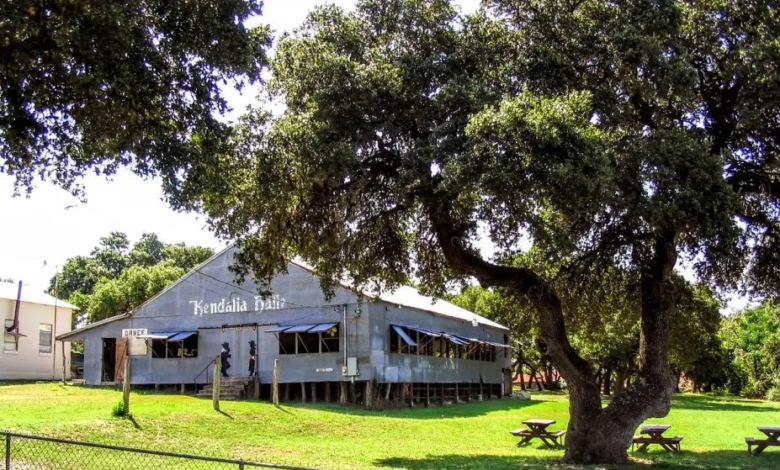Kendalia Halle

Introduction
Kendalia Halle is a historic Texas dance hall located in the small unincorporated community of Kendalia, nestled in the heart of the Hill Country. Known for its charming architecture, deep cultural roots, and over a century of history, the hall has been a cornerstone of community life for generations. For many locals and visitors alike, Kendalia Halle has been more than just a venue—it is a living symbol of Texas’ musical heritage and rural traditions.
Over the years, Kendalia Halle has hosted countless dances, live music events, weddings, fundraisers, and community gatherings. With origins dating back to the early 1900s, it stands as a rare surviving example of the classic German-style dance halls that once dotted the Texas countryside. While recent years have brought changes, including a suspension of events and a listing for sale, the legacy of Kendalia Halle continues to resonate with those who have experienced its magic.
The Origins of Kendalia Halle
The story of Kendalia Halle begins in 1903 when German immigrants and local community members sought to create a dedicated gathering place for music, dancing, and fellowship. The area around Kendalia was largely rural, with residents often traveling long distances for social activities. To meet this need, a group of locals came together to build a hall that would serve as the cultural heartbeat of the community.
Construction materials were carefully chosen for durability and beauty. Red fir lumber was brought in from Oregon, shipped by rail to nearby Boerne, and then transported to Kendalia by horse-drawn wagons. The hall was designed with a spacious wooden dance floor, high ceilings supported by sturdy timber trusses, and open space that could accommodate large crowds. From its first days, the Halle quickly became a beloved gathering spot.
Role in the Community
For decades, Kendalia Halle was the social center of the region. Families would gather there for monthly dances, often bringing homemade food and wearing their best attire. It was common for live bands to play traditional German polkas, waltzes, and later, country and western tunes. Children often played outside under the oak trees while adults danced inside, creating a warm and welcoming atmosphere that spanned generations.
The hall was also a venue for special occasions—weddings, anniversary celebrations, holiday events, and local fundraisers. During times of hardship, the community used the Halle for meetings and relief efforts. Its central role in local life made it an enduring symbol of unity and tradition.
Architectural Features
Kendalia Halle is a fine example of early 20th-century Texas dance hall design. The structure has a rectangular footprint with a wide-open interior designed to maximize dancing space. The hardwood dance floor is smooth and resilient, allowing for lively movement. Large windows provide natural ventilation, and the simple yet functional stage offers space for bands and performers.
One of the hall’s most distinctive features is its exposed wooden trusses, which not only support the high roof but also create an inviting, rustic aesthetic. Over the years, renovations have been done with care to preserve its original charm. Updates included stabilizing the foundation, straightening the frame, adding insulation, and restoring the red fir woodwork.
The Elbel Building and the Complex
Kendalia Halle is part of a larger property that includes the George Elbel Building, constructed in 1911. This building has its own history, having served various commercial and community purposes over the decades. The lower level of the Elbel Building once housed a Rathskeller-style bar, adding to the complex’s character.
The property also features a small residence, historically used for caretakers or as a rental space. The grounds cover approximately 2.3 acres, shaded by oak trees and offering open outdoor areas that enhance the venue’s appeal for gatherings.
Music and Cultural Legacy
The music played at Kendalia Halle reflects the evolution of Texas culture. Early on, German and Czech folk music dominated the scene, with polkas and waltzes setting the rhythm for dancers. As the decades passed, the hall embraced the growing popularity of country music, western swing, and rockabilly, drawing both local bands and regional favorites.
Many musicians considered playing at Kendalia Halle a rite of passage, and the venue built a reputation for intimate yet energetic shows. Dancers came from surrounding towns, sometimes traveling long distances just for a night of music under the hall’s warm lights.
Preservation Efforts
As Texas has modernized, many historic dance halls have fallen into disrepair or been replaced by newer entertainment venues. Kendalia Halle managed to survive thanks to community support and the dedication of its owners. In the mid-1990s, Lee and Judi Temple took ownership and committed themselves to preserving the hall’s historic charm while keeping it functional for modern events.
They ensured that repairs were made with authenticity in mind, using materials and methods that matched the hall’s original craftsmanship. Their stewardship earned praise from preservation organizations and kept Kendalia Halle active for many years.
Recent Closure
In July 2024, Kendalia Halle announced it would suspend events for the remainder of the year due to unforeseen circumstances. The news surprised the community, as the hall had maintained a steady schedule of monthly dances and special events up to that point. The cancellation of upcoming shows left regular attendees disappointed and concerned about the venue’s future.
Social media quickly filled with messages of support, memories, and hopes for a reopening. Many expressed that Kendalia Halle had been an important part of their lives and that losing it would be a cultural loss for the entire Hill Country.
The Sale of Kendalia Halle
In 2025, the property went on the market, listed for $550,000. The sale included the main dance hall, the Elbel Building, the residence, and the surrounding land. For preservationists and music lovers, this listing represented both a challenge and an opportunity—the chance for a new owner to revive the hall’s operations and continue its legacy.
The owners described the decision to sell as bittersweet, noting the countless memories made there and their hope that the next steward would appreciate its history. Preservation groups emphasized that the hall’s cultural significance made it worth saving, not just as a piece of real estate but as a living part of Texas history.
Why Kendalia Halle Matters
Kendalia Halle is one of the few remaining authentic rural dance halls in Texas. Its value lies not just in its age or architecture but in the role it has played in community life for more than a century. It represents the spirit of togetherness, the love of music, and the traditions of immigrant communities who helped shape Texas culture.
Preserving Kendalia Halle is about maintaining a space where people can connect face-to-face, dance to live music, and share experiences that transcend generations. In an era when many social interactions happen online, venues like Kendalia Halle offer a tangible connection to heritage and community.
Potential Future
The future of Kendalia Halle depends on the vision of its next owner. Ideal scenarios include reopening it as a dance hall and music venue, hosting weddings and community events, or developing it into a cultural heritage site with regular public access. There is also potential for adaptive reuse, such as turning the complex into a mixed-use space while preserving its historic character.
However, there is always the risk that a new owner may not prioritize preservation. Without a commitment to maintaining its historic elements, the hall could lose its authenticity—or even disappear altogether.
Community Hopes and Sentiments
For the residents of Kendalia and the surrounding Hill Country, the hall’s closure and sale have stirred deep emotions. Many have shared stories of meeting lifelong friends, celebrating milestones, and enjoying unforgettable nights of music and dancing within its walls. The hope is that someone will recognize its value, invest in its preservation, and reopen it to the public.
Community members have expressed a willingness to support fundraising, volunteer for maintenance, and help organize events if the hall returns to operation. This grassroots enthusiasm could be a critical factor in ensuring the hall’s survival.
Conclusion
Kendalia Halle stands as a testament to Texas’ enduring dance hall tradition. Since 1903, it has been a place where music, dance, and community come together in a way that is both timeless and uniquely local. Its architecture, cultural significance, and the memories it holds make it an irreplaceable part of the Hill Country’s heritage.
The hall’s recent closure and sale mark a pivotal moment in its history. Whether it reopens under new ownership or finds a new role in the community, the essence of Kendalia Halle—its music, its people, and its sense of belonging—will continue to inspire those who know its story. Saving it is not just about preserving a building; it is about keeping alive a piece of Texas’ cultural soul. blogvista.co.uk



